Kenwood KRC-435 User Manual

KRC-435
CASSETTE RECEIVER
INSTRUCTION MANUAL
AMPLI-TUNER-LECTEUR DE CASSETTE
MODE D’EMPLOI
RADIO CASSETTE
MANUAL DE INSTRUCCIONES
Take the time to read through this instruction manual.
Familiarity with installation and operation procedures will help you obtain the best performance from your new cassette-receiver.
For your records
Record the serial number, found on the back of the unit, in the spaces designated on the warranty card, and in the space provided below. Refer to the model and serial numbers whenever you call upon your KENWOOD dealer for information or service on the product.
Model KRC-435 Serial number
© B64-2235-00 (KW)
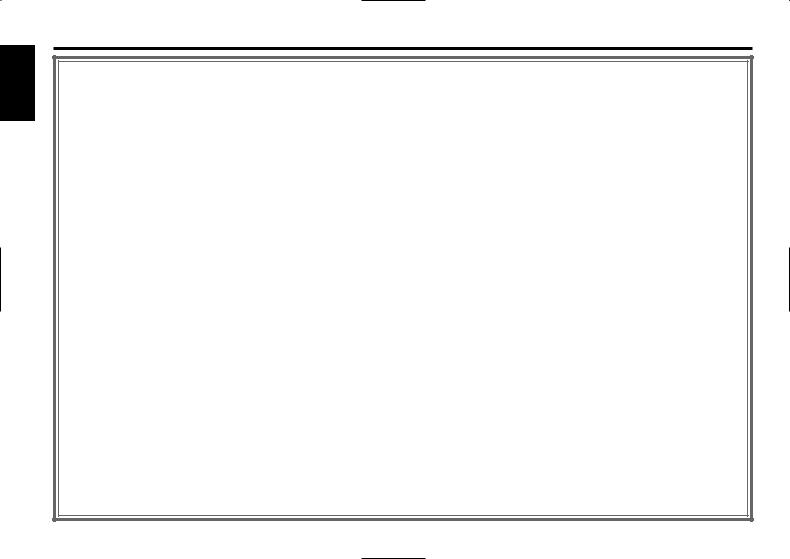
English
Contents
Safety precautions...................... |
3 |
About Cassette tape ................... |
4 |
General features ......................... |
5 |
Power
Selecting the Source
Volume
Attenuator
Loudness
System Q
Audio Control
Speaker Setting
Switching Display
Station/Disc Naming (SNPS/DNPS)
Auxiliary Input Display Setting
Theft Deterrent Faceplate
Tuner features |
...........................10 |
Tuning Mode
Tuning
Direct Access Tuning
Station Preset Memory
Auto Memory Entry
Preset Tuning
Cassette player features........... |
12 |
Menu system............................. |
17 |
Playing Cassette Tapes |
|
Menu System |
|
Fast Forwarding and Rewinding |
|
Security Code |
|
Dolby B NR |
|
Touch Sensor Tone |
|
Selecting the Tape type |
|
Manual Clock Adjustment |
|
Tape Advance |
|
DSI (Disabled System Indicator) |
|
Blank Skip |
|
Switching Graphic Display |
|
Music Repeat |
|
CRSC (Clean Reception System Circuit) |
|
External disc control features.. |
14 |
Text Scroll |
|
Playing External Disc |
|
Basic Operations of remote...... |
20 |
Fast Forwarding and Reversing |
|
Loading and Replacing the battery |
|
Track Search |
|
Basic operations |
|
Album Search |
|
In Tuner source |
|
Direct Track Search |
|
In Cassette tape source |
|
Direct Album Search |
|
In Disc source |
|
Track/Album Repeat |
|
Accessories ............................... |
23 |
Track Scan |
|
Installation Procedure |
23 |
Random Play |
|
||
|
Connecting Wires to Terminals 24 |
||
Magazine Random Play |
|
||
|
Installation |
25 |
|
Text/Title Scroll |
|
||
DNPP (Disc Name Preset Play) |
|
Troubleshooting Guide ............. |
27 |
|
|
Specifications ........................... |
31 |
— 2 —
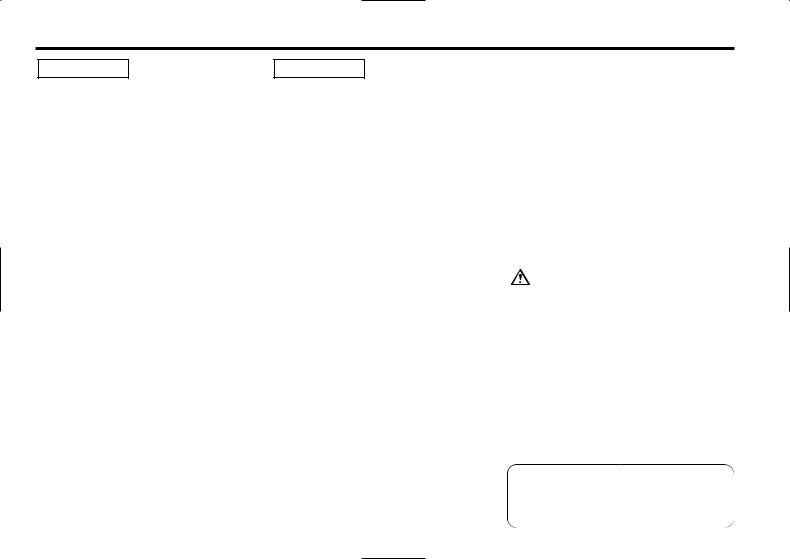
Safety precautions
2WARNING |
2CAUTION |
To prevent injury or fire, take the following precautions:
•Insert the unit all the way in until it is fully locked in place. Otherwise it may fall out of place when jolted.
•When extending the ignition, battery, or ground wires, make sure to use automotivegrade wires or other wires with a 0.75mm2 (AWG18) or more to prevent wire deterioration and damage to the wire coating.
•To prevent a short circuit, never put or leave any metallic objects (such as coins or metal tools) inside the unit.
•If the unit starts to emit smoke or strange smells, turn off the power immediately and consult your Kenwood dealer.
•Make sure not to get your fingers caught between the faceplate and the unit.
•Be careful not to drop the unit or subject it to strong shock.
The unit may break or crack because it contains glass parts.
•Do not touch the liquid crystal fluid if the LCD is damaged or broken due to shock. The liquid crystal fluid may be dangerous to your health or even fatal.
If the liquid crystal fluid from the LCD contacts your body or clothing, wash it off with soap immediately.
To prevent damage to the machine, take the following precautions:
•Make sure to ground the unit to a negative 12V DC power supply.
•Do not open the top or bottom covers of the unit.
•Do not install the unit in a spot exposed to direct sunlight or excessive heat or humidity. Also avoid places with too much dust or the possibility of water splashing.
•Do not set the removed faceplate or the faceplate case in areas exposed to direct sunlight, excessive heat or humidity. Also avoid places with too much dust or the possibility of water splashing.
•To prevent deterioration, do not touch the terminals of the unit or faceplate with your fingers.
•Do not subject the faceplate to excessive shock, as it is a piece of precision equipment.
•When replacing a fuse, only use a new one with the prescribed rating. Using a fuse with the wrong rating may cause your unit to malfunction.
•To prevent a short circuit when replacing a fuse, first disconnect the wiring harness.
•Do not place any object between the faceplate and the unit.
•Do not use your own screws. Use only the screws provided. If you use the wrong screws, you could damage the unit.
— 3 —
IMPORTANT INFORMATION
About the disc changer/CD player to be connected:
To connect a disc changer having the "O-N" switch to this unit, set the "O-N" switch to "N". To connect a disc changer having no "O-N" switch to this unit, the converter cord CADS100 and/or switching adapter KCA-S210A are required as options.
A disc changer doesn't work when it is connected without using these options.
If a model with no "O-N" switch is connected, some unavailable functions and information that cannot be displayed are generated. Note that none of the KDC-C100, KDC-C302, C205, C705, and non-Kenwood CD changers can be connected.
You can damage both your unit and the CD changer if you connect them incorrectly.
FCC WARNING
This equipment may generate or use radio frequency energy. Changes or modifications to this equipment may cause harmful interference unless the modifications are expressly approved in the instruction manual. The user could lose the authority to operate this equipment if an unauthorized change or modification is made.
Manufactured under license from Dolby Laboratories.
“Dolby” and the double-D symbol are trademarks of Dolby Laboratories.
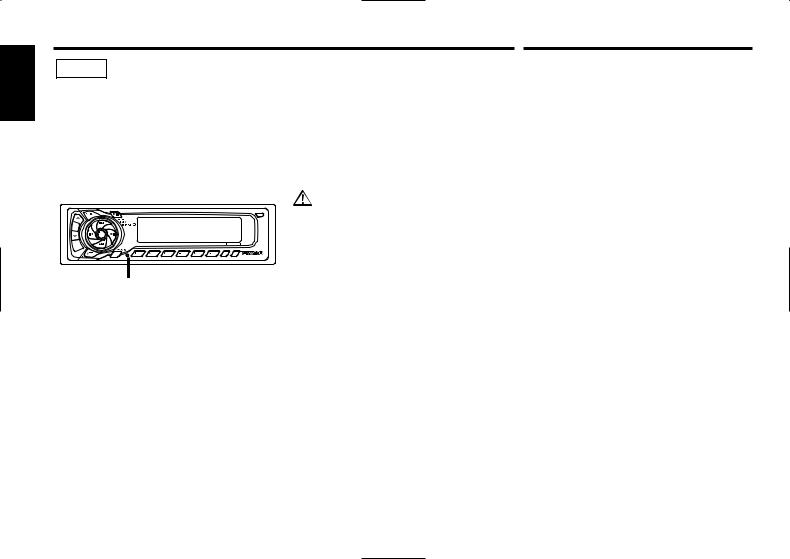
English
Safety precautions
NOTE
•If you experience problems during installation, consult your Kenwood dealer.
•If the unit does not seem to be working right, try pressing the reset button first. If that does not solve the problem, consult your Kenwood dealer.
•Press the reset button if the Disc auto changer fails to operate correctly. Normal operation should be restored.
OFF
|
DAB |
|
|
|
|
|
B NR |
SCAN |
B.S./RDM |
REP |
MTL/M.RDM DISP NAME AUTO AME |
LOUD |
|
|
|
|
|
Cleaning the Faceplate Terminals
If the terminals on the unit or faceplate get dirty, wipe them with a dry, soft cloth.
Cleaning the Unit
If the faceplate of this unit is stained, wipe it with a dry soft cloth such as a silicon cloth.
If the faceplate is stained badly, wipe the stain off with a cloth moistened with neutral cleaner, then wipe neutral detergent off.
Applying spray cleaner directly to the unit may affect its mechanical parts. Wiping the faceplate with a hard cloth or using a volatile liquid such as thinner or alcohol may scratch the surface or erases characters.
Reset button
•We recommend the use of the Security Code function (see p.18) to prevent theft.
•Characters in the LCD may become difficult to read in temperatures below 41 ˚F (5 ˚C).
•The illustrations of the display and the panel appearing in this manual are examples used to explain more clearly how the controls are used. Therefore, what appears on the display in the illustrations may differ from what appears on the display on the actual equipment, and some of the illustrations on the display may represent something impossible in actual operation.
About Cassette tape
Cleaning the tape head
When there’s noise or the sound quality is bad during tape play the tape head maybe dirty, clean the tape head.
About Cassette tape
•If the tape is slack tighten it.
•If the cassette tape label is peeling off glue it on again.
•Don’t use deformed cassette tape.
•Don’t place cassette tape on the dashboard etc. where the temperature is high.
•Don’t use cassette tape that’s 100 minutes long or longer.
— 4 —
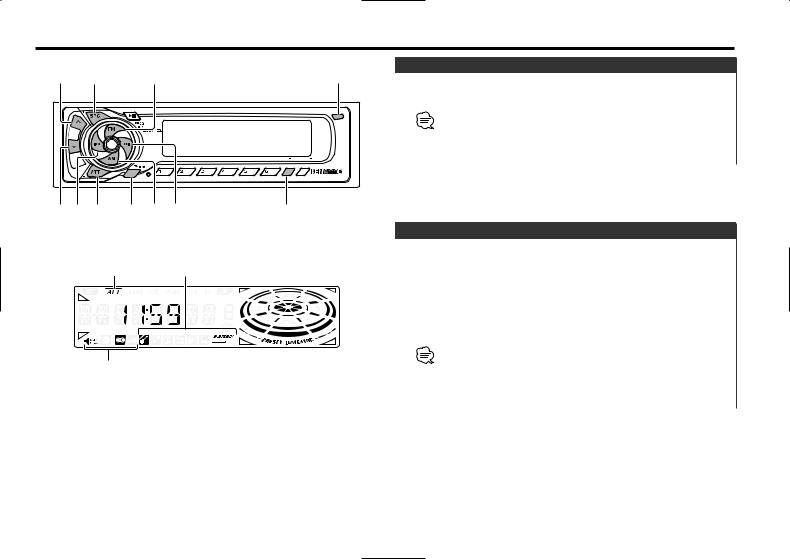
General features
|
SRC/ |
|
|
Release button |
u PWR OFF |
|
FM |
||
|
|
|||
|
OFF |
|
|
|
|
DAB |
|
|
|
|
|
|
B NR SCAN B.S./RDM REP |
MTL/M.RDM DISP NAME AUTO AME |
|
LOUD |
|
|
|
d |
4 ATT/ |
Q/ |
AM ¢ |
DISP/ |
|
||||
|
LOUD |
AUD |
|
NAME |
|
ATT indicator |
SYSTEM Q indicator |
|
|
Speaker Setting indicator
Power
Turning ON the Power
Press the [SRC] button.
When the power is ON, the <Security Code> (page 18) is displayed as "CODE ON" or "CODE OFF".
Turning OFF the Power
Press the [SRC] button for at least 1 second.
Selecting the Source
Press the [SRC] button. |
|
Source required |
Display |
Tuner |
"TUNER" |
Tape |
"TAPE" |
External disc |
"DISC-CH" |
Auxiliary input |
"AUX" |
Standby (Illumination only mode) |
"ALL OFF" |
For Auxiliary input one of the below optional accessories is necessary.
-KCA-S210A
-CA-C1AX
-CD changer with an Auxiliary input function installed.
— 5 —
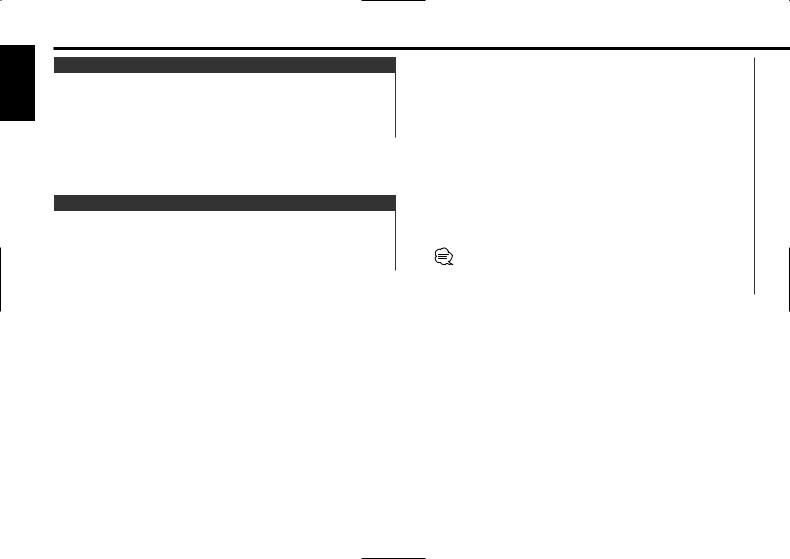
English
General features
Volume
Increasing Volume
Press the [u] button.
Decreasing Volume
Press the [d] button.
Attenuator
Turning the volume down quickly.
Press the [ATT] button.
Each time the button is pressed the Attenuator turns ON or OFF. When it’s ON, the "ATT" indicator blinks.
1Select the source to set
Press the [SRC] button.
2Select the Sound type
Press the [Q] button.
Each time the button is pressed the sound setting switches.
Sound setting |
Display |
Flat |
"FLAT" |
User memory |
"USER" |
Rock |
"ROCK" |
Pops |
"POPS" |
Easy |
"EASY" |
Top 40 |
"TOP40" |
Jazz |
"JAZZ" |
•User memory: The values set on the <Audio control> (page 6).
•Each setting value is changed with the <Speaker setting> (page 7).
First, select the speaker type with the Speaker setting.
Loudness |
|
|
|
Compensating for low and high tones during low volume. |
|
|
|
Press the [LOUD] button for at least 1 second. |
|
|
|
Audio Control |
|||
Each time the button is pressed for at least 1 second the |
|
1 |
Select the source for adjustment |
Loudness turns ON or OFF. |
|
||
When it's ON, "LOUD ON" is displayed. |
|
|
Press the [SRC] button. |
|
|
2 |
Enter Audio Control mode |
|
|
|
Press the [AUD] button for at least 1 second. |
|
|
3 |
Select the Audio item for adjustment |
|
|
|
Press the [FM] or [AM] button. |
System Q |
|
|
|
|
|
Each time the button is pressed the items that can be adjusted |
|
You can recall the best sound setting preset for different types of |
|
|
|
|
|
switch as shown below. |
|
the music. |
|
4 |
Adjust the Audio item |
|
|
||
— 6 —

Press the [4] or [¢] button.
Adjustment Item |
Display |
Range |
Bass level |
"BAS" |
–8 — +8 |
Middle level |
"MID" |
–8 — +8 |
Treble level |
"TRE" |
–8 — +8 |
Balance |
"BAL" |
Left 15 — Right 15 |
Fader |
"FAD" |
Rear 15 — Front 15 |
Volume offset |
"V-OFF" |
–8 — ±0 |
Volume offset: Each source's volume can be set as a difference from the basic volume.
5Exit Audio Control mode
Press the [AUD] button.
Speaker Setting
For 5 |
& 4 in. speaker |
"SP 5/4" |
For 6 |
& 6x9 in. speaker |
"SP 6*9/6" |
For the OEM speaker |
"SP OEM" |
|
4Exit Speaker Setting mode
Press the [Q] button.
Fine-tuning so that the System Q value is optimal when setting the speaker type.
1Enter Standby
Press the [SRC] button.
Select the "ALL OFF" display.
2Enter Speaker Setting mode
Press the [Q] button.
3Select the Speaker type
Press the [4] or [¢] button.
Each time the button is pressed the setting switches as shown below.
Speaker type |
Display |
OFF |
"SP OFF" |
— 7 —

English
General features
Switching Display
Switching the information displayed.
Press the [DISP] button.
Each time the button is pressed the display switches as shown below.
In Tuner source |
|
|
|
Information |
Display |
|
Frequency |
|
|
Station name |
"SNPS" |
|
Clock |
|
In Tape source |
|
|
|
Information |
|
|
Play side |
|
|
Tape running |
|
|
Clock |
|
In External disc source |
|
|
|
Information |
Display |
|
Track number & Track Time |
|
|
Disc name |
"DNPS" |
|
Disc title |
"D-TITLE" |
|
Track title |
"T-TITLE" |
|
Clock |
|
Station/Disc Naming (SNPS/DNPS)
Attaching a title to a Station or CD.
1Receive/play the station/disc you want to attach a title to
•A title can't be attached to a MD.
•Disc Naming can't be done during CD text or clock display.
2Enter name set mode
Press the [NAME] button for at least 2 seconds.
"NAME SET" is displayed.
3Move the cursor to the enter character position
Press the [4] or [¢] button.
4Select the characters
Press the [FM] or [AM] button.
Characters can be entered by using a remote with a number buttons.
Example: If "DANCE" is entered.
Character |
Button |
#Times pressed |
"D" |
[#3] |
1 |
"A" |
[#2] |
1 |
"N" |
[#6] |
2 |
"C" |
[#2] |
3 |
"E" |
[#3] |
2 |
5Repeat steps 3 through 4 and enter the name.
6Exit name set mode
Press the [NAME] button.
•When operation stops for 10 seconds the name at that time is registered, and Name Set mode closes.
•Memory numbers
-FM: 32 stations
-AM: 16 stations
-External CD changer/ player: Varies according to the CD changer/ player. Refer to the CD changer/ player manual.
•The title of station/CD can be changed by the same operation
— 8 —

used to name it.
Auxiliary Input Display Setting
Selecting the display when this device is switched to Auxiliary input source.
1Select Auxiliary input source
Press the [SRC] button.
Select the "AUX" display.
2Enter Auxiliary input display setting mode
Press the [DISP] button for at least 2 seconds.
The presently selected AUX Name is blinks.
3Select the Auxiliary input display
Press the [4] or [¢] button.
Each time the button is pressed it switches through the below displays.
•"AUX"
•"TV"
•"VCP"
•"GAME"
•"PORTABLE"
•"DVD"
4Exit Auxiliary input display setting mode
Press the [DISP] button.
•When operation stops for 10 seconds, the name at that time is selected, and Auxiliary input display setting mode closes.
•This function doesn't work when CA-C1AX is used.
— 9 —
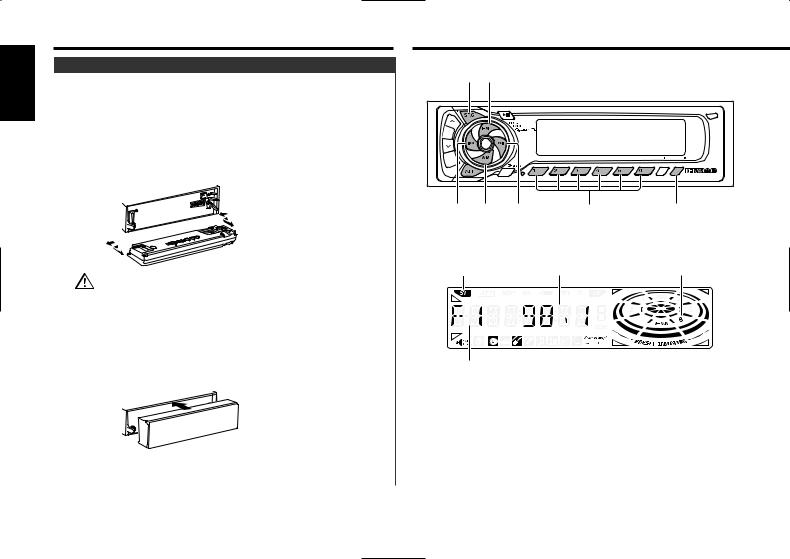
English
General features
Theft Deterrent Faceplate
The faceplate of the unit can be detached and taken with you, helping to deter theft.
Removing the Faceplate
1Press the Release button.
Drop open the faceplate.
2Drawing the faceplate to left side pull it to the front and remove it.
• The faceplate is a precision piece of equipment and can be damaged by shocks or jolts. For that reason, keep the faceplate in its special storage case while detached.
•Do not expose the faceplate or its storage case to direct sunlight or excessive heat or humidity. Also avoid places with too much dust or the possibility of water splashing.
Reattaching the Faceplate
1Align the shaft on the unit with the depression on the faceplate.
2Push the faceplate in until it clicks.
The faceplate is locked in place, allowing you to use the unit.
Tuner features
SRC |
FM |
|
|
|
OFF |
|
|
|
|
|
DAB |
|
|
|
|
|
B NR SCAN |
B.S./RDM REP |
MTL/M.RDM DISP NAME AUTO AME |
LOUD |
|
|
|
|
4 AM |
¢ |
# 1-6 |
AUTO/ |
|
|
|
|
|
AME |
ST indicator |
Frequency display |
Preset station number |
||
Band display
— 10 —
